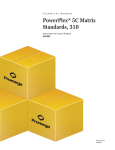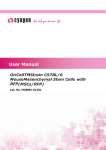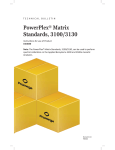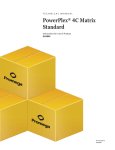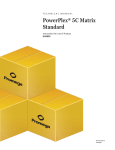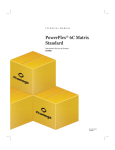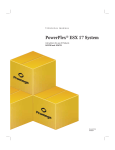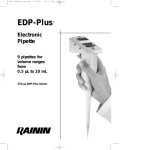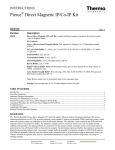Download PowerPlex® 5-Dye Matrix Standards, 3100/3130
Transcript
Technical Bulletin PowerPlex® 5-Dye Matrix Standards, 3100/3130 INSTRUCTIONS FOR USE OF PRODUCTS DG4700. Note: These matrix fragments are compatible with the ABI PRISM® 3100 and 3100-Avant and Applied Biosystems 3130, 3130xl, 3500 and 3500xL Genetic Analyzer. PRINTED IN USA. Revised 2/11 Part# TBD024 PowerPlex® 5-Dye Matrix Standards, 3100/3130 All technical literature is available on the Internet at: www.promega.com/tbs/ Please visit the web site to verify that you are using the most current version of this Technical Bulletin. Please contact Promega Technical Services if you have questions on use of this system. E-mail: [email protected]. 1. Description..........................................................................................................1 2. Product Components and Storage Conditions ............................................2 3. Instrument Preparation and Spectral Calibration Using the Applied Biosystems 3500 and 3500xL Genetic Analyzers ..................3 A. Matrix Sample Preparation.................................................................................3 B. Instrument Preparation .......................................................................................5 4. Instrument Preparation and Spectral Calibration Using Data Collection Software, Version 2.0 or Version 3.0 (ABI PRISM® 3100 and 3100-Avant and Applied Biosystems 3130 and 3130xl Genetic Analyzers) ............................................................................................9 A. Matrix Sample Preparation.................................................................................9 B. Instrument Preparation .....................................................................................11 5. Troubleshooting...............................................................................................14 A. Applied Biosystems 3500 and 3500xL Genetic Analyzers ...........................14 B. ABI PRISM® 3100 and 3100-Avant and Applied Biosystems 3130 and 3130xl Genetic Analyzers .................................................................14 6. Related Products ..............................................................................................15 1. Description Proper generation of a spectral calibration file is critical to evaluate multicolor systems with the ABI PRISM® 3100 and 3100-Avant and Applied Biosystems 3130, 3130xl, 3500 and 3500xL Genetic Analyzers. The PowerPlex® 5-Dye Matrix Standards, 3100/3130(a–c), consists of DNA fragments labeled with five different fluorescent dyes: one tube contains a DNA fragment labeled with fluorescein, one tube contains a DNA fragment labeled with JOE, one tube contains a DNA fragment labeled with TMR-ET, one tube contains a DNA fragment labeled with CXR-ET, and one tube contains a DNA fragment labeled with CC5. Promega Corporation · 2800 Woods Hollow Road · Madison, WI 53711-5399 USA Toll Free in USA 800-356-9526 · Phone 608-274-4330 · Fax 608-277-2516 · www.promega.com Printed in USA. Revised 2/11 Part# TBD024 Page 1 1. Description (continued) These matrix fragments are mixed and used on the ABI PRISM® 3100 or 3100Avant or Applied Biosystems 3130, 3130xl, 3500 or 3500xL Genetic Analyzer to perform a spectral calibration on a specified dye set. The spectral calibration should be performed on dye set G5. Once generated, this file is applied during sample detection to calculate the spectral overlap between the five different dyes and separate the raw fluorescent signals into individual dye signals. The PowerPlex® 5-Dye Matrix Standards, 3100/3130, was developed for use with the 5-dye PowerPlex® Systems. A matrix should be generated for each individual instrument. Protocols for operation of the ABI PRISM® 3100 or 3100Avant or Applied Biosystems 3130, 3130xl, 3500 or 3500xL Genetic Analyzer should be obtained from the manufacturer. 2. Product Components and Storage Conditions Product PowerPlex® 5-Dye Matrix Standards, 3100/3130 Not for Medical Diagnostic Use. Includes: • • • • • • 25µl 25µl 25µl 25µl 25µl 1.25ml Size 25µl (each dye) Cat.# DG4700 Fluorescein Matrix, 5-Dye (3100/3130) JOE Matrix, 5-Dye (3100/3130) TMR-ET Matrix, 5-Dye (3100/3130) CXR-ET Matrix, 5-Dye (3100/3130) CC5 Matrix, 5-Dye (3100/3130) Nuclease-Free Water Storage Conditions: Store all components at –20°C in a nonfrost-free freezer. The matrix standards fragments are light-sensitive and must be stored in the dark. We strongly recommend that the matrix standards be stored with postamplification reagents and used separately with different pipettes, tube racks, etc. Do not store the diluted matrix standard fragments. Promega Corporation · 2800 Woods Hollow Road · Madison, WI 53711-5399 USA Toll Free in USA 800-356-9526 · Phone 608-274-4330 · Fax 608-277-2516 · www.promega.com Part# TBD024 Page 2 Printed in USA. Revised 2/11 3. Instrument Preparation and Spectral Calibration Using the Applied Biosystems 3500 and 3500xL Genetic Analyzers Materials to Be Supplied by the User • 95°C dry heating block, water bath or thermal cycler • crushed ice or ice-water bath • centrifuge compatible with 96-well plates • aerosol-resistant pipette tips • 3500/3500xL capillary array, 36cm • performance optimized polymer 4 (POP-4™) in a pouch for the 3500 or 3500xL • anode buffer container with 1X buffer • cathode buffer container with 1X buffer • conditioning reagent pouch for the 3500 or 3500xL • MicroAmp® optical 96-well plate and septa • Hi-Di™ formamide (Applied Biosystems Cat.# 4311320) ! The quality of formamide is critical. Use Hi-Di™ formamide. Freeze formamide in aliquots at –20°C. Multiple freeze-thaw cycles or long-term storage at 4°C may cause breakdown of formamide. Poor-quality formamide may contain ions that compete with DNA during injection, which results in lower peak heights and reduced sensitivity. A longer injection time may not increase the signal. ! Formamide is an irritant and a teratogen; avoid inhalation and contact with skin. Read the warning label, and take the necessary precautions when handling this substance. Always wear gloves and safety glasses when working with formamide. For additional information on performing spectral calibration, refer to the Applied Biosystems 3500/3500xL Genetic Analyzer User Guide. 3.A. Matrix Sample Preparation ! There may be instrument-to-instrument variation in the sensitivity of detection. The dilutions described here may need to be optimized in individual laboratories, depending on the sensitivity of each Applied Biosystems 3500 or 3500xL Genetic Analyzer. 1. Thaw the matrix standards on ice. Mix each matrix standard by vortexing each tube for 5–10 seconds prior to use. Do not centrifuge the matrix standards as this may cause the DNA to be concentrated at the bottom of the tube. Place on ice. 2. Initial dilution of concentrated fragments: Before combining the matrix standards, dilute the individual matrix standards 1:10 in Nuclease-Free Water, as described below. Vortex for 5–10 seconds to mix. Place on ice. Component Fluorescein Concentrated Dye 5µl Nuclease-Free Water 45µl JOE 5µl 45µl TMR-ET CXR-ET 5µl 5µl 45µl 45µl CC5 5µl 45µl Promega Corporation · 2800 Woods Hollow Road · Madison, WI 53711-5399 USA Toll Free in USA 800-356-9526 · Phone 608-274-4330 · Fax 608-277-2516 · www.promega.com Printed in USA. Revised 2/11 Part# TBD024 Page 3 3.A. Matrix Sample Preparation (continued) 3. Fragment mix (using 1:10 dilutions of matrix standards): After the initial dilution in Step 2, combine the 1:10 dilution of each matrix standard as directed below. Vortex for 5–10 seconds to mix. Component Hi-Di™ formamide Fluorescein from initial dilution JOE from initial dilution TMR-ET from initial dilution CXR-ET from initial dilution CC5 from initial dilution Volume 665µl 7.0µl 7.0µl 7.0µl 7.0µl 7.0µl 4. On the Applied Biosystems 3500xL Genetic Analyzer, only wells A1 to H3 of the 96-well plate are used for spectral calibration. Load 25μl of the fragment mix prepared in Step 3 into each of the 24 wells. After placing the septa on the plate, briefly centrifuge the plate to remove bubbles. On the Applied Biosystems 3500 Genetic Analyzer, only wells A1 to H1 of the 96-well plate are used for spectral calibration. Load 25μl of the fragment mix prepared in Step 3 into each of the 8 wells. After placing the septa on the plate, briefly centrifuge the plate to remove bubbles. 5. Denature samples at 95°C for 3 minutes, then immediately chill on crushed ice or in an ice-water bath for 3 minutes. Denature samples just prior to loading the instrument. 6. Place the plate in the 3500 series 96-well standard plate base, and cover with the plate retainer. Place the plate assembly in Position A on the autosampler with the labels facing you. Promega Corporation · 2800 Woods Hollow Road · Madison, WI 53711-5399 USA Toll Free in USA 800-356-9526 · Phone 608-274-4330 · Fax 608-277-2516 · www.promega.com Part# TBD024 Page 4 Printed in USA. Revised 2/11 3.B. Instrument Preparation 9247TA 1. Set the oven temperature to 60°C, then select the Start Pre-Heat icon at least 30 minutes prior to the first injection to preheat the oven (Figure 1). Figure1. The Dashboard. The arrow highlights the pre-heat options. Promega Corporation · 2800 Woods Hollow Road · Madison, WI 53711-5399 USA Toll Free in USA 800-356-9526 · Phone 608-274-4330 · Fax 608-277-2516 · www.promega.com Printed in USA. Revised 2/11 Part# TBD024 Page 5 3.B. Instrument Preparation (continued) 2. To perform a spectral calibration with the Promega 5-dye chemistry, a new dye set should be created. If a new dye set was created previously, proceed to Section 3.B, Step2.c. a. To create this new dye set, navigate to the Library, highlight “Dye Sets” and select “Create”. 9325TA b. The Create a New Dye Set tab will appear (Figure 2). Name the Dye Set, select “Matrix Standard” for the Chemistry and select “G5 Template” for the Dye Set Template. Select “Save”. Figure 2. Create New Dye Set. Promega Corporation · 2800 Woods Hollow Road · Madison, WI 53711-5399 USA Toll Free in USA 800-356-9526 · Phone 608-274-4330 · Fax 608-277-2516 · www.promega.com Part# TBD024 Page 6 Printed in USA. Revised 2/11 c. To perform the spectral calibration with the Promega 5-dye chemistry, go to the Maintenance tab, select “Spectral”, and under the Calibration Run tab, choose the appropriate fields: Choose “Matrix Standard” from the Chemistry Standard pull-down menu and the new Promega 5-dye set created in Step 2b (i.e., Promega G5) from the Dye Set pull-down menu (Figure 3). d. Select “Start Run”. Figure 3. Calibration Run. Promega Corporation · 2800 Woods Hollow Road · Madison, WI 53711-5399 USA Toll Free in USA 800-356-9526 · Phone 608-274-4330 · Fax 608-277-2516 · www.promega.com Printed in USA. Revised 2/11 Part# TBD024 Page 7 3.B. Instrument Preparation (continued) 3. If fewer than the recommended number of capillaries pass, the spectral calibration run will be repeated automatically up to three times. Upon completion of the spectral calibration, check the quality of the spectral in the Capillary Run Data display (Figure 4), and choose either “Accept” or “Reject”. 9327TA Note: Refer to the 3500 Series Data Collection Software Version 1.0 HID User Manual for the criteria recommended by Applied Biosystems when accepting or rejecting a spectral calibration. Figure 4. The Capillary Run Data display. Promega Corporation · 2800 Woods Hollow Road · Madison, WI 53711-5399 USA Toll Free in USA 800-356-9526 · Phone 608-274-4330 · Fax 608-277-2516 · www.promega.com Part# TBD024 Page 8 Printed in USA. Revised 2/11 4. Instrument Preparation and Spectral Calibration Using Data Collection Software, Version 2.0 or Version 3.0 (ABI PRISM® 3100 and 3100-Avant and Applied Biosystems 3130 and 3130xl Genetic Analyzers) Materials to Be Supplied by the User • 95°C dry heating block, water bath or thermal cycler • crushed ice or an ice-water bath • centrifuge compatible with 96-well plates • • • • • • 3100 or 3130 capillary array, 36cm performance optimized polymer 4 (POP-4™) for the 3100 or 3130 10X genetic analyzer buffer with EDTA MicroAmp® optical 96-well plate aerosol-resistant pipette tips Hi-Di™ formamide (Applied Biosystems Cat.# 4311320) ! The quality of formamide is critical. Use Hi-Di™ formamide. Freeze formamide in aliquots at –20°C. Multiple freeze-thaw cycles or long-term storage at 4°C may cause breakdown of formamide. Poor-quality formamide may contain ions that compete with DNA during injection, which results in lower peak heights and reduced sensitivity. A longer injection time may not increase the signal. ! Formamide is an irritant and a teratogen; avoid inhalation and contact with skin. Read the warning label, and take appropriate precautions when handling this substance. Always wear gloves and safety glasses when working with formamide. 4.A. Matrix Sample Preparation There may be instrument-to-instrument variation in the sensitivity of detection. The dilutions described here may need to be optimized in individual laboratories, depending on the sensitivity of each ABI PRISM® 3100 or 3100-Avant or Applied Biosystems 3130 or 3130xl Genetic Analyzer. The optimal dilution may differ for each dye fragment. You also may need to adjust injection time or voltage in Section 4.B to achieve a passing spectral calibration. Peak heights in the range of 1,000–4,000RFU are ideal. Peak heights above 750RFU are required. The same plate of matrix standards can be re-injected up to four times. To re-inject the same matrix standards plate, add an injection by selecting “Plate Manager”, then “Edit”. Select “Edit” again in the top left corner of the window, then select “Add sample run”. Injection time and voltage may require optimization to obtain peak heights above 750RFU and below the saturation point. 1. Thaw the matrix standards on ice. Mix each matrix standard by vortexing for 5–10 seconds prior to use. Do not centrifuge the matrix standards as this may cause the DNA to be concentrated at the bottom of the tube. Place on ice. Promega Corporation · 2800 Woods Hollow Road · Madison, WI 53711-5399 USA Toll Free in USA 800-356-9526 · Phone 608-274-4330 · Fax 608-277-2516 · www.promega.com Printed in USA. Revised 2/11 Part# TBD024 Page 9 4.A. Matrix Sample Preparation (continued) 2. Initial dilution of concentrated fragments: Before combining the matrix standards, dilute the individual matrix standards 1:10 in Nuclease-Free Water, as described below. Vortex for 5–10 seconds to mix. Place on ice. Component Fluorescein Concentrated Dye 5µl Nuclease-Free Water 45µl JOE 5µl 45µl TMR-ET CXR-ET 5µl 5µl 45µl 45µl CC5 5µl 45µl 3. Fragment mix (using 1:10 dilutions of matrix standards): After the initial dilution in Step 2, combine the 1:10 dilutions as directed below. Vortex for 5–10 seconds to mix. Component Hi-Di™ formamide Fluorescein from initial dilution JOE from initial dilution TMR-ET from initial dilution CXR-ET from initial dilution CC5 from initial dilution Volume 475µl 5.0µl 5.0µl 5.0µl 5.0µl 5.0µl 4. On the ABI PRISM® 3100 and Applied Biosystems 3130xl Genetic Analyzers, 16 wells are used for spectral calibration on 16 capillaries (wells A1 through H2 of a 96-well plate). Load 25µl of fragment mix prepared in Step 3 into each of the 16 wells. Briefly centrifuge the plate to remove bubbles. On the ABI PRISM® 3100-Avant and Applied Biosystems 3130 Genetic Analyzers, four wells are used for spectral calibration on four capillaries (wells A1 through D1 in a 96-well plate). Load 25µl of fragment mix into each of the four wells. Briefly centrifuge the plate to remove any bubbles. 5. Denature samples at 95°C for 3 minutes, then immediately chill on crushed ice or in an ice-water bath for 3 minutes. Denature samples just prior to loading the instrument. Promega Corporation · 2800 Woods Hollow Road · Madison, WI 53711-5399 USA Toll Free in USA 800-356-9526 · Phone 608-274-4330 · Fax 608-277-2516 · www.promega.com Part# TBD024 Page 10 Printed in USA. Revised 2/11 4.B. Instrument Preparation We have found that the use of fresh polymer and new capillary array results in an optimal spectral. 8283TA Representative raw data are shown in Figure 5. Another example of a passing spectral calibration in the Spectral Viewer is shown in Figure 6. Figure 5. Representative data for the PowerPlex® 5-Dye Matrix Standards, 3100/3130, on the Applied Biosystems 3130 Genetic Analyzer using Foundation Data Collection Version 3.0. Figure shows the CC5, CXR-ET, TMR-ET, JOE and fluorescein peaks in the raw data profile from each of the four capillaries in the Capillaries Viewer. Promega Corporation · 2800 Woods Hollow Road · Madison, WI 53711-5399 USA Toll Free in USA 800-356-9526 · Phone 608-274-4330 · Fax 608-277-2516 · www.promega.com Printed in USA. Revised 2/11 Part# TBD024 Page 11 8198TA 4.B. Instrument Preparation (continued) Figure 6. Representative data for the PowerPlex® 5-Dye Matrix Standards, 3100/3130, on the Applied Biosystems 3130 Genetic Analyzer using data collection software, version 3.0. Figure shows the CC5 (orange), CXR-ET (red), TMR-ET (yellow), JOE (green) and fluorescein (blue) peaks in the Spectral Viewer from one of the four capillaries. 1. Prepare matrix samples as previously described in Section 4.A. Note: Differences in instrument sensitivity may result in peak imbalance or reduced peak height of the matrix standards. You may need to adjust injection time or voltage to achieve a passing spectral calibration. You also may need to prepare a new plate and adjust the dilution of individual matrix standards. Peak heights in the range of 1,000–4,000RFU are ideal. Peak heights above 750RFU and below the saturation point of the instrument are required. 2. Perform the spectral calibration as described in the ABI PRISM® 3100 or 3100-Avant or Applied Biosystems 3130 or 3130xl Genetic Analyzer User’s Manual with the following modifications: a. In the Module Manager, select “New.” Select “Spectral” in the Type drop-down list, and select “Spect36_POP4” in the Template drop-down list. Confirm or change the following settings: Inj. kV: Inj. Secs: Data Delay Time: Run time: 1.2 12 400 700 seconds Promega Corporation · 2800 Woods Hollow Road · Madison, WI 53711-5399 USA Toll Free in USA 800-356-9526 · Phone 608-274-4330 · Fax 608-277-2516 · www.promega.com Part# TBD024 Page 12 Printed in USA. Revised 2/11 b. Create a new name for the run module, then select “OK”. c. In the Protocol Manager, under Instrument Protocols select “New”. Type a name for your protocol. Make the following selections in the Protocol Editor: • • • • • • “Spectral” in the Type drop-down list “G5” in the DyeSet drop-down list “POP4” for the polymer “36” in the Array Length drop-down list “Matrix Standard” for the chemistry Select the spectral module you created in the previous step in the Run Module drop-down list. Finally, select “Edit Parameters”, and make the following modifications: • Change the lower condition bound to 4.0, and change the upper condition bound to 12.0. • Confirm that the Minimum Quality Score is 0.95 Select “OK” in the Edit Parameters window, and select “OK” in the Protocol Editor. Note: The condition number (“C value”) obtained when generating a spectral calibration will vary with the instrument. After obtaining a spectral calibration that performs acceptably, the condition bounds range in the previous step may be narrowed to more critically evaluate C values for subsequent spectral calibrations. d In the Plate Manager, create a new plate record as described in the instrument user’s manual. In the dialog box that appears, select “Spectral Calibration” in the Application drop-down list, and select “96-well” as the plate type. Add entries in the owner and operator windows, name the plate and select “OK.” e. In the spectral calibration plate editor dialog box, place sample names in the appropriate cells. In the Instrument Protocol column, select the protocol you created in Step 2.c. Ensure that this information is present for each row that contains a sample name. Select “OK.” f. Run your plate as described in the instrument user’s manual. g. Upon completion of the run, check the status of the spectral calibration in the Event Log window. For the ABI PRISM® 3100 and Applied Biosystems 3130xl Genetic Analyzers, we recommend that a minimum of 12 of the 16 capillaries pass calibration. For the ABI PRISM® 3100-Avant and Applied Biosystems 3130 Genetic Analyzers, we recommend that a minimum of three of four capillaries pass calibration. If fewer than the recommended numbers of capillaries pass, repeat the spectral calibration. Promega Corporation · 2800 Woods Hollow Road · Madison, WI 53711-5399 USA Toll Free in USA 800-356-9526 · Phone 608-274-4330 · Fax 608-277-2516 · www.promega.com Printed in USA. Revised 2/11 Part# TBD024 Page 13 5. Troubleshooting For questions not addressed here, please contact your local Promega Branch Office or Distributor. Contact information available at: www.promega.com. E-mail: [email protected] 5.A. Applied Biosystems 3500 and 3500xL Genetic Analyzers Symptoms Causes and Comments Fewer than the recommended number of capillaries passed the spectral calibration Matrix standards were too dilute. Matrix samples that are too dilute will result in low peak heights, which may result in spectral calibration failure or bleedthrough or oversubtraction in other dye colors. Decrease the dilution of each fragment in Step 2 of Section 3A. Matrix standards were too concentrated. Matrix samples that are too concentrated may result in spectral calibration failure or bleedthrough or oversubtraction in other dye colors. Increase the dilution of each fragment in Step 2 of Section 3.A. Samples were not denatured completely. Incomplete denaturation can cause extra peaks. Heat-denature samples for the recommended time, and cool on crushed ice or in an ice-water bath immediately prior to loading the capillary. Do not cool samples in a thermal cycler or –20°Cfreezer. 5.B. ABI PRISM® 3100 and 3100-Avant and Applied Biosystems 3130 and 3130xl Genetic Analyzers Symptoms Causes and Comments Fewer than the recommended number of capillaries passed the spectral calibration Peak heights for the matrix standards were too low. Increase the injection voltage or time. If the matrix peak heights are below 1,000RFU, decrease the dilution of each fragment in Step 2 of Section 4.A, and repeat the spectral calibration. Peak heights for the matrix standards were too high. Decrease the injection voltage or time. Matrix sample peak heights that are too high may result in spectral calibration failure. If matrix sample peak heights are too high (>5,000RFU), increase the dilution of each fragment in Step 2 of Section 4.A, and repeat the spectral calibration. For best spectral calibration results, use a fresh bottle of polymer, fresh buffer and water, and a capillary array with fewer than 100 injections. Promega Corporation · 2800 Woods Hollow Road · Madison, WI 53711-5399 USA Toll Free in USA 800-356-9526 · Phone 608-274-4330 · Fax 608-277-2516 · www.promega.com Part# TBD024 Page 14 Printed in USA. Revised 2/11 Symptoms Causes and Comments All capillaries failed spectral calibration Monitoring fragment migration in the Capillaries Viewer during the spectral calibration run can provide information that will be useful for troubleshooting purposes. Re-inject the spectral calibration plate, and monitor the Capillaries Viewer during the run. Note any unusual peak formations, extremely high or low peak heights. Based on information obtained while watching the Capillary Viewer, it may be necessary to adjust the run conditions. Samples were degraded due to improper storage. Store matrix standards at –20°C and protected from light. Do not store in the freezer door, and do not store in a frost-free freezer. 6. Related Products Product PowerPlex® 18D System PowerPlex® ESX 16 System PowerPlex® ESX 17 System PowerPlex® ESI 16 System PowerPlex® ESI 17 System Size 200 reactions 800 reactions 100 reactions 400 reactions 100 reactions 400 reactions 100 reactions 400 reactions 100 reactions 400 reactions Cat.# DC1802 DC1808 DC6711 DC6710 DC6721 DC6720 DC6771 DC6770 DC6781 DC6780 Size 50ml 6,250µl (5 × 1,250µl) 50µl (each dye) Cat.# P1193 DW0991 DG4600 Not for Medical Diagnostic Use. Accessory Components Product Nuclease-Free Water* Water, Amplification Grade* PowerPlex® 5-Dye Matrix Standards, 310** *For Laboratory Use. **Not for Medical Diagnostic Use. Promega Corporation · 2800 Woods Hollow Road · Madison, WI 53711-5399 USA Toll Free in USA 800-356-9526 · Phone 608-274-4330 · Fax 608-277-2516 · www.promega.com Printed in USA. Revised 2/11 Part# TBD024 Page 15 (a)This product or portions thereof is manufactured and sold under license from GE Healthcare under patents Austria Pat. No. E236994, Australia Pat. No. 692230, Belgium Pat. No. 0743987, Switzerland Pat. Nos. 0743987 and 0851867, Germany Pat. Nos. 19581489, 69530286.8 and 0851867, EP Pat. Nos. 0743987 and 0851867, Spain Pat. Nos. 2197193 and 2173310, France Pat. Nos. 0743987 and 0851867, United Kingdom Pat. Nos. 0743987 and 0851867, Italy Pat. Nos. 0743987 and 0851867, Liechtenstein Pat. Nos. 0743987 and 0851867, Netherlands Pat. Nos. 0743987 and 0851867, Sweden Pat. Nos. 0743987 and 0851867, U.S. Pat. Nos. 5,654,419, 5,688,648, 5,869,255, 6,177,247, 5,707,804, 6,028,190, 6,544,744, 7,015,000 and 5,728,528, Canada Pat. No. 2231475, Japan Pat. No. 3066984 and other pending and foreign patent applications. (b)End User Terms and Conditions Acceptance. These terms and conditions shall govern the purchase, use, transfer and acceptance of the products described in the purchase order, quotation or invoice, which products are sold and distributed by Promega to the buyer/transferee of such products (the "End User"). The transfer/sale of products to the End User is expressly conditional upon End User's acceptance of these terms and conditions. Restrictions on Use. End Users are specifically not authorized to and are forbidden from reselling, transferring or distributing any products either as a stand alone product or as a component of another product. The right to use the products does not, in and of itself, include or carry any right of the End User to any GE Healthcare Bio-Sciences Corp.'s technology or intellectual property other than expressly provided herein. End Users may not use sequence(s) in an attempt to reverse engineer parameters of any of GE Healthcare Bio-Sciences Corp. proprietary products or services. Disclaimer of Warranties. GE Healthcare Bio-sciences Corp. provides no warranties to end user (statutory or implied), including without limitation, as to product quality, condition, description, merchantability or fitness for a particular purpose, and all such warranties are hereby expressly disclaimed. GE Healthcare Bio-Sciences Corp. hereby expressly disclaims any warranty regarding results obtained through the use of the products, including without limitation any claim of inaccurate, invalid or incomplete results. Exclusion of Liability. GE Healthcare Bio-Sciences Corp. and its affiliates shall have no liability to an End User, including, without limitation, for any loss of use or profits, business interruption or any consequential, incidental, special or other indirect damages of any kind, regardless of how caused and regardless of whether an action in contract, tort, strict product liability or otherwise. (c)TMR-ET, CXR-ET and CC5 dyes are proprietary. © 2009, 2011 Promega Corporation. All Rights Reserved. PowerPlex is a registered trademark of Promega Corporation. ABI PRISM and MicroAmp are registered trademarks of Applera Corporation. Hi-Di and POP-4 are trademarks of Applera Corporation. Products may be covered by pending or issued patents or may have certain limitations. Please visit our Web site for more information. All prices and specifications are subject to change without prior notice. Product claims are subject to change. Please contact Promega Technical Services or access the Promega online catalog for the most up-to-date information on Promega products. Promega Corporation · 2800 Woods Hollow Road · Madison, WI 53711-5399 USA Toll Free in USA 800-356-9526 · Phone 608-274-4330 · Fax 608-277-2516 · www.promega.com Part# TBD024 Page 16 Printed in USA. Revised 2/11


















